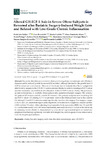Altered GH-IGF-1 axis in severe obese subjects is reversed after bariatric surgery-induced weight loss and related with low-grade chronic inflammation

Use este enlace para citar
http://hdl.handle.net/2183/26337
Excepto si se señala otra cosa, la licencia del ítem se describe como Creative Commons Attribution 4.0 International License (CC-BY 4.0)
Colecciones
- Investigación (FCS) [1293]
Metadatos
Mostrar el registro completo del ítemTítulo
Altered GH-IGF-1 axis in severe obese subjects is reversed after bariatric surgery-induced weight loss and related with low-grade chronic inflammationAutor(es)
Fecha
2020-08-12Cita bibliográfica
Juiz-Valiña P, Pena-Bello L, Cordido M, Outeiriño-Blanco E, Pértega S, Varela-Rodriguez B, Garcia-Brao MJ, Mena E, Sangiao-Alvarellos S, Cordido F. Altered GH-IGF-1 axis in severe obese subjects is reversed after bariatric surgery-induced weight loss and related with low-grade chronic inflammation. J Clin Med. 2020 Aug 12;9(8):2614.
Resumen
[Abstract] Endocrine disorders are common in obesity, including altered somatotropic axis. Obesity is characterized by reduced growth hormone (GH) secretion, although the insulin-like growth factor-1 (IGF-1) values are controversial. The aim of this study was to evaluate the effect of weight loss after bariatric surgery in the GH–IGF-1 axis in extreme obesity, in order to investigate IGF-1 values and the mechanism responsible for the alteration of the GH–IGF-1 axis in obesity. We performed an interventional trial in morbidly obese patients who underwent bariatric surgery. We included 116 patients (97 women) and 41 controls (30 women). The primary endpoint was circulating GH and IGF-1 values. Circulating IGF-1 values were lower in the obese patients than in the controls. Circulating GH and IGF-1 values increased significantly over time after surgery. Post-surgery changes in IGF-1 and GH values were significantly negatively correlated with changes in C-reactive protein (CRP) and free T4 values. After adjusting for preoperative body mass index (BMI), free T4 and CRP in a multivariate model, only CRP was independently associated with IGF-1 values in the follow-up. In summary, severe obesity is characterized by a functional hyposomatotropism at central and peripheral level that is progressively reversible with weight loss, and low-grade chronic inflammation could be the principal mediator.
Palabras clave
Obesity
Bariatric surgery
Endocrine disorders
Somatotropic axis
GH
IGF-1
Bariatric surgery
Endocrine disorders
Somatotropic axis
GH
IGF-1
Versión del editor
Derechos
Creative Commons Attribution 4.0 International License (CC-BY 4.0)
ISSN
2077-0383






